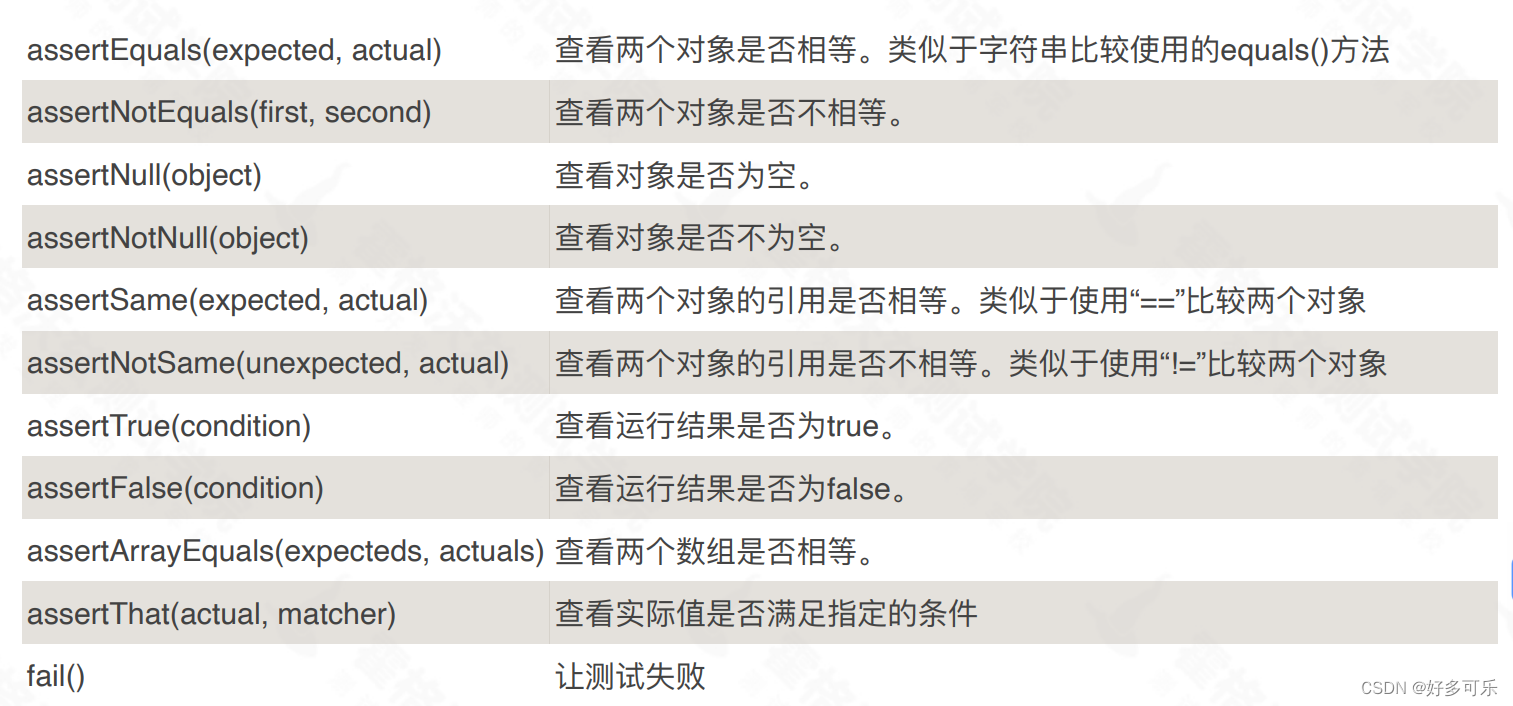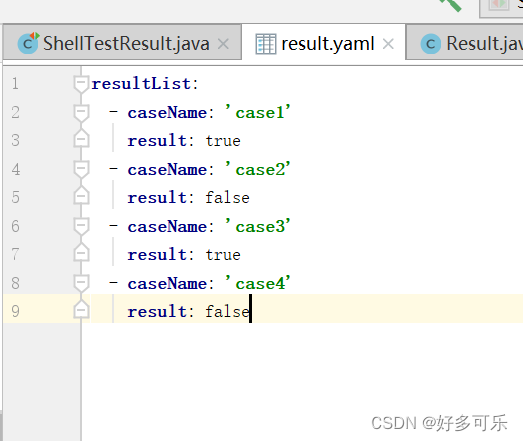文章目录
- 一,导入依赖
- 二,基本功能
- 一、常用断言
- 二、执行顺序和常用注解
- 1、通过BeforeAll类的注解来保证顺序
- 2、通过order注解来保证执行顺序
- 三、依赖测试
- 四、参数化测试
- 五、测试套件
- SelectPackages、IncludePackages、SelectClasses、IncludeTags等注解的使用
- 六、软断言
- 七、并发测试
- 八、动态测试解决硬编码问题
- 九、Junit5启动类(适用于持续集成)
Junit5的构成:
- Junit Platform+Junit Jupiter+Junit Vintage
- Junit Platform:是Junit向测试平台演进,提供平台功能的模块,通过这个其他的自动化引擎可以接入Junit,实现对接和执行
- Junit Jupiter:核心,承载Juint4原有功能+丰富的新特性
- Junit Vintage:主要功能是对Juint旧版本进行兼容
一,导入依赖
<properties><maven.compiler.source>8</maven.compiler.source><maven.compiler.target>8</maven.compiler.target><project.build.sourceEncoding>UTF-8</project.build.sourceEncoding><junit-platform.version>1.8.1</junit-platform.version><junit-jupiter.version>5.8.1</junit-jupiter.version></properties><build><pluginManagement><plugins><plugin><groupId>org.apache.maven.plugins</groupId><artifactId>maven-surefire-plugin</artifactId><version>3.0.0-M5</version><dependencies><dependency><groupId>org.junit.jupiter</groupId><artifactId>junit-jupiter-engine</artifactId><version>5.8.1</version></dependency></dependencies><configuration><includes><include>**/*Test.java</include></includes></configuration></plugin><plugin><groupId>org.apache.maven.plugins</groupId><artifactId>maven-compiler-plugin</artifactId><version>3.8.1</version><configuration><source>1.8</source><target>1.8</target></configuration></plugin></plugins></pluginManagement></build><!--核心依赖--><dependency><groupId>org.junit.jupiter</groupId><artifactId>junit-jupiter-engine</artifactId><version>5.8.1</version></dependency><!--套件测试使用--><dependency><groupId>org.junit.platform</groupId><artifactId>junit-platform-runner</artifactId><version>1.8.1</version></dependency><dependency><groupId>org.junit.platform</groupId><artifactId>junit-platform-runner</artifactId><version>1.8.1</version></dependency>
二,基本功能
一、常用断言

二、执行顺序和常用注解
1、通过BeforeAll类的注解来保证顺序
// 执行顺序:beforeAll-beforeEach-afterEach-afterAll
@DisplayName("常用注解测试")
public class TestCase {/*** @BeforeAll和@AfterAll 必须静态修饰,在所有方法执行前后只执行一次* @Test 一个方法* @AfterEach和@BeforeEach 每次方法执行前都会执行一次* @DisplayName() 类似注解的功能* @RepeatedTest(5) 重复5次* @Disabled 不执行该方法* @Tags 打标签*/@BeforeAllpublic static void beforeAll() {System.out.println("BeforeAll再每个类中只执行一次,且是在开头执行");}@BeforeEachpublic void beforeEach() {System.out.println("BeforeEach在每个方法执行前都会执行一次");}// junit5不需要访问修饰符// @Disabled表示不执行@Test@Disabled@DisplayName("方法1")void fun1() {System.out.println("---fun1---");}@Test@DisplayName("方法2")@RepeatedTest(5)void fun2() {System.out.println("---fun2---");}@Test@Tag("tag1")void tagTest(){System.out.println("tag1");}@AfterEachpublic void afterEach() {System.out.println("AfterEach在每个方法执行前都会执行一次");}@AfterAllpublic static void afterAll() {System.out.println("afterAll再每个类中只执行一次,且是在结尾执行");}
}2、通过order注解来保证执行顺序
import org.junit.jupiter.api.MethodOrderer.OrderAnnotation;
import org.junit.jupiter.api.Order;
import org.junit.jupiter.api.Test;
import org.junit.jupiter.api.TestMethodOrder;@TestMethodOrder(OrderAnnotation.class)
class OrderedTestsDemo {@Test@Order(1)void nullValues() {// perform assertions against null values}@Test@Order(2)void emptyValues() {// perform assertions against empty values}@Test@Order(3)void validValues() {// perform assertions against valid values}
}
- allure注解

三、依赖测试
/*** @Nested:* 功能类似于suite测试套件* 从下往上执行*/public class NestedTest {private static HashMap<String, Object> dataMap = new HashMap<String, Object>();@Testvoid login() {dataMap.put("login", "登录成功");}@Nestedclass Shopping{@Testvoid shopping(){if (null!=dataMap.get("buy")){System.out.println("购买成功啦!");}else {System.out.println("购买失败");}}}@Nestedclass Buy {@Testvoid buyTest() {if (dataMap.get("login").equals("登录成功")) {System.out.println("登录成功");dataMap.put("buy", "登录成功,快去购物吧!");} else {System.out.println("登录失败");}}}
}
四、参数化测试
写过一篇,点这里!!
五、测试套件
SelectPackages、IncludePackages、SelectClasses、IncludeTags等注解的使用
/*** SelectPackages 选择需要执行的包*/
@RunWith(JUnitPlatform.class)
@SelectPackages({"com.testCase2"})
public class SelectPackagesTest {}
/*** @IncludePackages需要和@SelectPackages搭配使用* @IncludePackages是在@SelectPackages的基础上再做一层筛选* ps:一定要注意,包下的类名一定要Test开头或者结尾,否则就不执行了!!!*/
@RunWith(JUnitPlatform.class)
@SelectPackages({"com.testCase2"})
// 只执行com.testCase2.demo1
@IncludePackages({"com.testCase2.demo1"})
public class IncludePackagesTest {
}
/*** @SelectClasses和@IncludeTags组合使用,在方法里选出对应的标签* 还有@ExcludeTag*/
@RunWith(JUnitPlatform.class)
@SelectClasses({TestCase.class})
//@IncludeTags("tag1")
@ExcludeTags("tag1")
public class SelectClassesTest {
}六、软断言
- assertAll断言方法,会在执行完所有断言后统⼀输出结果,⼀次性暴露所有问题,提高了测试脚本的健壮性。
import org.junit.jupiter.api.Assertions;
import org.junit.jupiter.api.Test;
import org.junit.jupiter.api.function.Executable;import java.util.ArrayList;
import java.util.List;import static org.junit.jupiter.api.Assertions.assertAll;public class AssertAllDemo {// 普通方法,第一个执行失败以后后面都不执行@Testvoid assertTest1() {Assertions.assertTrue(2 == 1);}void assertTest2() {Assertions.assertTrue(3 == 1);}void assertTest3() {Assertions.assertTrue(1 == 1);}// 用了assertAll之后,所有方法都执行@Testvoid assertAllTest() {assertAll("多次结果校验",() -> {Assertions.assertTrue(2 == 1);},() -> {Assertions.assertTrue(3 == 1);});}@Testvoid assertAllTtest02() {List<Executable> assertList = new ArrayList<>();for (int i = 0; i < 10; i++) {int result = i;System.out.println(result);assertList.add(() -> {Assertions.assertEquals(10, result);});}assertAll("多次结果校验", assertList.stream());}}七、并发测试
- 测试环境基本上都是单线程操作,而线上存在分布式的并发场景,所以并不能暴露所有问题,这里就需要用到并发
- junit测试是在⼀个线程中串行执行的,从5.3开始⽀持并行测试。⾸先需要在配置⽂件junit-platform.properties 中配置。
#是否允许并行执行true/false
junit.jupiter.execution.parallel.enabled = true
#是否支持方法级别多线程same_thread/concurrent
junit.jupiter.execution.parallel.mode.default = concurrent
#是否支持类级别多线程same_thread/concurrent
junit.jupiter.execution.parallel.mode.classes.default = concurrent
# the maximum pool size can be configured using a ParallelExecutionConfigurationStrategy
junit.jupiter.execution.parallel.config.strategy=fixed
junit.jupiter.execution.parallel.config.fixed.parallelism=4
import org.junit.jupiter.api.RepeatedTest;
import org.junit.jupiter.api.Test;/*** 并发测试*/
public class ParallelTest {static int result = 0;// 加synchronized可以保证其原子性,但是如果是分布式系统是不适合的,需要用如redis分布式锁public static int cal(int x) throws InterruptedException {int i = result;Thread.sleep(1000);result = i + x;return result;}public static int add(int x,int y) throws InterruptedException {Thread.sleep(1000);result = y + x;return result;}@RepeatedTest(10)public void testCal() throws InterruptedException {long id = Thread.currentThread().getId();System.out.println("线程" + id + "为你服务:" + cal(1));}@RepeatedTest(10)public void testAdd() throws InterruptedException {long id = Thread.currentThread().getId();System.out.println("加法计算:线程" + id + "为你服务:" + add(1,2));}
}
八、动态测试解决硬编码问题
- 传统自动化测试思路中,我们的测试逻辑是在以硬编码的形式组织到代码里的,当遇到用例迁移或结果整合时,会产生大量的逻辑重写
- JUnit5提供了动态测试方案,让测试人员可以在脚本Runtime时动态的批量生成用例
- 现在我们有一个需求,要把yaml文件内容转为测试用例,解决思路如下:

import com.fasterxml.jackson.databind.ObjectMapper;
import com.fasterxml.jackson.dataformat.yaml.YAMLFactory;
import org.junit.jupiter.api.Assertions;
import org.junit.jupiter.api.DynamicTest;
import org.junit.jupiter.api.Test;
import org.junit.jupiter.api.TestFactory;import java.io.File;
import java.io.IOException;
import java.util.ArrayList;
import java.util.Collection;
import java.util.List;/*** 动态测试demo* 需求:把result.yaml脚本变成测试用例* 首先把它通过反序列化变成对象* 然后把它添加到dynamicTestList*/
public class ShellTestResult {@TestFactoryCollection<DynamicTest> shellTestResult() throws IOException {// 新建一个列表来存储数据(不是结果)List<DynamicTest> dynamicTestList = new ArrayList<>();ObjectMapper mapper = new ObjectMapper(new YAMLFactory());// 反序列化方式把yaml文件转换为对象列表ResultList resultList = mapper.readValue(new File("D:\\interface_auto\\src\\main\\resources\\result.yaml"), ResultList.class);System.out.println("done");// 动态遍历生成测试方法for (Result result : resultList.getResultList()) {// 把数据收集起来dynamicTestList.add(// 动态生成测试方法DynamicTest.dynamicTest(result.getCaseName(), () -> {Assertions.assertTrue(result.isResult());}));}return dynamicTestList;}
}import lombok.Data;@Data
public class Result {private String caseName;private boolean result;public boolean isResult() {return result;}public void setResult(boolean result) {this.result = result;}
}
@Data
public class ResultList {private List<Result> resultList;
}
九、Junit5启动类(适用于持续集成)
import org.junit.platform.launcher.Launcher;
import org.junit.platform.launcher.LauncherDiscoveryRequest;
import org.junit.platform.launcher.TestExecutionListener;
import org.junit.platform.launcher.core.LauncherDiscoveryRequestBuilder;
import org.junit.platform.launcher.core.LauncherFactory;
import org.junit.platform.launcher.listeners.SummaryGeneratingListener;import static org.junit.platform.engine.discovery.ClassNameFilter.includeClassNamePatterns;
import static org.junit.platform.engine.discovery.DiscoverySelectors.selectClass;
import static org.junit.platform.engine.discovery.DiscoverySelectors.selectPackage;/*** junit5启动类(适用于持续集成这种点不了执行的)*/
public class LauncherDemo {public static void main(String[] args) {LauncherDiscoveryRequest request = LauncherDiscoveryRequestBuilder.request().selectors(// 2个过滤条件是or不是and:selectPackage("com.learn.junit5"),selectClass(TestExecutionOrder.class)).filters(
// includeClassNamePatterns("Test.*")).build();Launcher launcher = LauncherFactory.create();TestExecutionListener listener = new SummaryGeneratingListener();launcher.registerTestExecutionListeners(listener);launcher.execute(request);}
}


)






)


C++的类型转换)

![[office] excel如何计算毛重和皮重的时间间隔 excel计算毛重和皮重时间间隔方法 #笔记#学习方法](http://pic.xiahunao.cn/[office] excel如何计算毛重和皮重的时间间隔 excel计算毛重和皮重时间间隔方法 #笔记#学习方法)

(vim)(配置白名单sudo))

